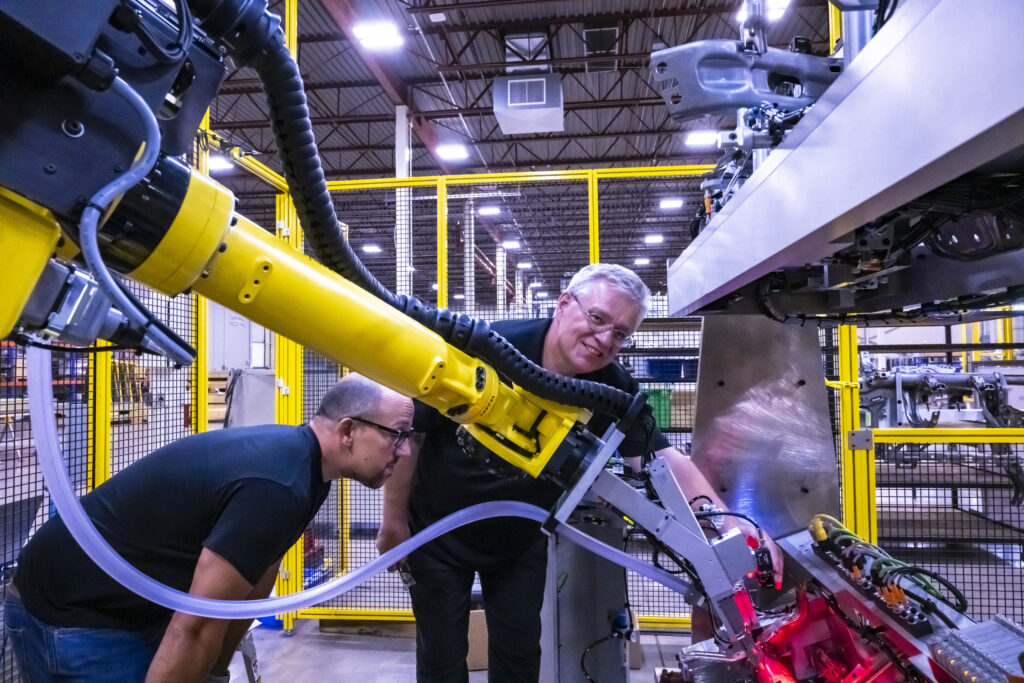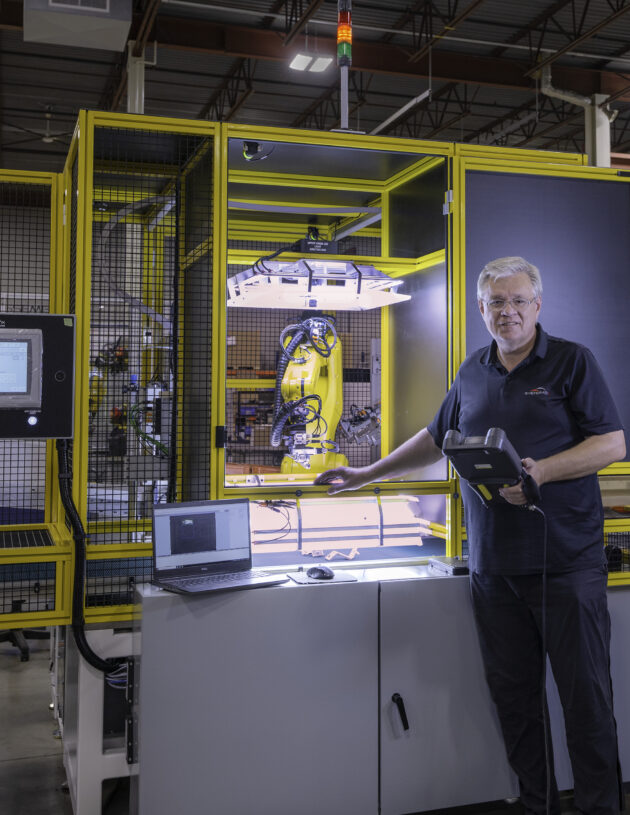
Michal Goc, Lifetime Achievement Award winner is breaking barriers to achieve the impossible
November 27, 2023
By
Sukanya Ray Ghosh
Lifetime Achievement Award winner Michal Goc has created a legacy of solving the most challenging automation problems with an innovative mind and constant perseverance.
 Michal Goc has established himself as an expert in machine vision systems with the reputation of never giving up. (Photo: Systematix)
Michal Goc has established himself as an expert in machine vision systems with the reputation of never giving up. (Photo: Systematix) Automation has often had the misfortune of being misunderstood as a segment that takes away jobs. The scope of automation technologies has expanded quite rapidly. Industrial automation, in particular, has redefined job roles and skills required to work in manufacturing facilities today. It has removed the necessity of human beings working in dull, dirty and dangerous environments. It is important to remember, however, that the success of these technologies is dependent on the people who implement and use them every day.
To celebrate trendsetters and legends in the industrial automation space, Manufacturing AUTOMATION introduced the Lifetime Achievement Award this year. The 2023 award goes to Michal Goc, senior controls and vision integrator at Systematix, a Samuel Automation facility.
Goc has been an enthusiastic trailblazer in industrial automation for more than 32 years now. Early in his career, he found his passion for solving problems using innovative machine vision solutions. Over the course of 22 years in this field, he has developed and refined his expertise.
Goc’s enthusiasm and passion for automation can be traced back to his childhood years when automated toys fascinated him immensely. Even as a child, he often enjoyed tinkering with the toys, adding small controls and motors to make them move.
Goc shares that choosing automation as his career was a no-brainer for him. He graduated in electrical engineering, the closest field of study related to automation that was available at that time. He, thereafter, opted for courses that aligned accordingly.
Right out of school, Goc began working in the field of industrial automation, first in manufacturing facilities in their service departments. He then moved on to engineering firms where he started developing products and engineering solutions and continues to do so even today.
“What always fuelled my drive and motivation when I was young was when someone told me a task was impossible. I would work really hard on such problems and figure out a way to solve them, make them possible,” says Goc.
The team at Systematix, where Goc currently works, shares that his skill in solving intricate vision-related problems has been a driving factor in the company’s continuous advancement to solve emerging challenges. His creation of specialized algorithms, including the Flatness Check, Perpendicularity and Parallelism check, and the multi-axis coordinated servo motion control, demonstrates his practical approach to addressing complex issues. These innovations reflect his role in guiding the company over the years to overcome new vision obstacles and keep pushing the boundaries in the field.
Goc’s approach to developing advanced vision solutions is rooted in practicality and innovation.
Memorable automation projects
When asked about his most memorable automation projects, he says that there have been too many over the years to pick just one.
He adds, “I have been working for a long time on a vision system for our company called Machine Vision Systematix, or Mavix. This system has created a sort of legacy for Systematix. Many customers come to us just for this vision system. This project really excites me.”
Mavix is a PC-based multicamera vision inspection system that provided the company with its own set of advanced vision solutions for complex applications, giving it a competitive edge in the industry.
Goc’s utilization of artificial intelligence (AI) and deep learning hardware and software adds another layer of sophistication to these solutions, enhancing their capabilities. His expertise also extends to developing custom optics and lighting solutions, showcasing his problem-solving skills.
Goc shares that another memorable automation project was one where the geometry of the motion was complicated.
“I had to use mathematical skills to calculate the trajectory and convert the rotational motion of the servo and transition it to some sort of path in a linear motion. That was an exciting project where I was doing calculations for a system which was moved by two servos, but the final motion was on a sinusoidal path. It was supposed to be super-fast, and the servos were just moving the arms and stuff. I get very excited when there is complicated math involved in a project,” he says.
Another project that involved complex math was where the requirement was to create algorithms to calculate whether the surface was plain or whether the shafts were perpendicular to other surfaces. The algorithms were created using advanced math.
Working with ever-evolving technologies
When Goc began his career, automation was often based on relay technology, he reminisces. Today, there has been a major shift towards computer and software-based solutions such as PLC logic controllers, for example.
“When I entered the world of machine vision around 2000-2001, such systems enhanced the world of automation. We could actually see things, even though the technology was quite primitive in the beginning. There have been so many advancements in this area over the years. For example, around 2010, AI and deep learning algorithms came into the machine vision world and opened up other options to see and do other things more reliably. This turned the previously impossible tasks into possible,” recalls Goc.
He remembers working on a project where it took him about three months to create vision algorithms using classic standard tools. When Goc completed a short course on deep learning and used these algorithms to solve the same problem, it took him two days and produced the same results.
Goc shares that the perception regarding what technology can or cannot do has also changed over the years.
“Sometimes people believe in science fiction and other incredible ideas which cannot be replicated in a real industrial setting. Such perceptions are now more balanced. I have also on previous occasions tried working on such solutions, but they are not reliable in the real world. We now understand better that automation technologies can solve certain problems and not solve some others,” he explains.

(Photo: Systematix)
Envisioning the future of vision
Goc has seen machine vision technologies evolve over the years in ways that have redefined what can be achieved with automation. To understand where the technology is headed in the future, it is important to take a look at what has changed and how, he says.
“It started as a system where you would purchase the different parts and pieces of hardware and put all of them together to create the solution. You would purchase lights, lenses and cameras, configure them on the computer and then program them yourself. It required a lot of self-development,” says Goc. “Then, companies developed smart cameras that came in a small box and possessed the necessary capabilities. You could purchase them in one place and deploy them very quickly. But they also had limitations.”
Goc says that vision cameras today have extremely high resolutions, sometimes as high as 64 megapixels. He adds that he recently worked on a line-scan solution that needed 105 megapixels of camera resolution. Commercially available vision systems were unable to support it. The customer-preferred system was only able to go up to 64 megapixels. The customer tried another system but that had communication issues and did not perform well. They even hired expert consultants in this field to try to resolve the issue but to no avail. Eventually, Goc and his teammates at Systematix worked on an in-house software matrix that was able to solve the issue at hand. He feels especially proud of this achievement.
Goc notes that in the near future, he sees the vision segment headed toward even higher resolution cameras. He adds that the processing power of computers will also develop accordingly to support these advances.
“There is a demand on optics to support such high-resolution images. Software, combined with AI and deep learning capabilities, will eventually be able to extract the information from the image at high speed and high resolution. We are currently trying to highlight features with different types of lighting scenarios. The technology already exists to do back lighting, dark field lighting, front lighting, bright field lighting, on-axis lighting, diffused lighting, direct lighting and so on, to make it easier for the camera and software to determine what is a good part versus a bad part or to guide a robot. Today, there are attempts to use generic lighting combined with high resolution cameras or cameras from multiple angles to create 3D images and extract features with AI. This allows for a more human-like inspection. This is where the technology is headed,” says Goc.
He adds that there is still a long road ahead for vision systems to reach that level of sophistication. And the market still exists for the smaller vision cameras to solve the simpler problems that manufacturers regularly encounter.
Committed to his craft
Goc’s commitment to automation is grounded in practical actions that benefit both Systematix and its clients. His role extends beyond work within the company and for customers. With a hands-on approach to industry improvement, he has even collaborated with Cognex to enhance their vision algorithms.
His contributions go beyond the office, as he offers webinars to customers and shares insights in industry publications, promoting practical knowledge exchange. He also plays a vital role in training the next generation of vision integrators, ensuring the future of skilled professionals.
Goc strives to make the machines work right with his solutions, even when the starting point is frustrating and presents as a Herculean task.
“Even when I’m not able to find a way out, I keep working on the problem till I do. People have now come to believe in me. They trust me to figure out the solution eventually. This is a big achievement for me,” he says.
He adds that when an automation project seems too big, he starts with the small section of the task that he is most familiar with. He has learnt to work his way up slowly, tackling every challenge as it comes along. It is easy to feel scared when you don’t know the complete solution at the get-go, he says.
To the next generation of professionals entering the automation workforce, he says it is important to have the willingness to learn.
“In our field, things change very quickly. New technologies are launched multiple times a year. So, you have to be able to learn and explore to identify the best solution. If something works, do not feel satisfied and walk away. Try different approaches to see if there is a better way. Strive for 100 percent results. The automation solution should be good enough to continue performing well for years to come,” he says. | MA
Advertisement
- CME urges swift action from government to support manufacturing sector and drive economic growth
- Heddle Shipyards boosts manufacturing capabilities with $107 million investment